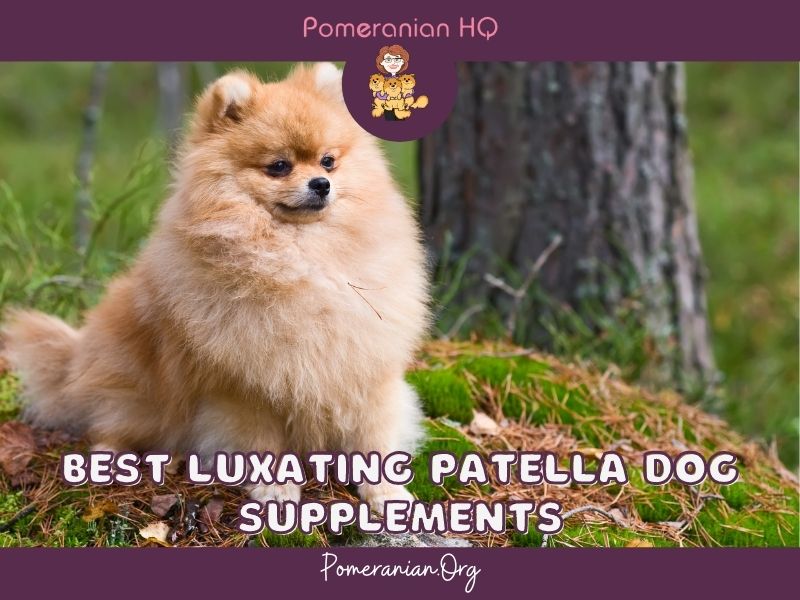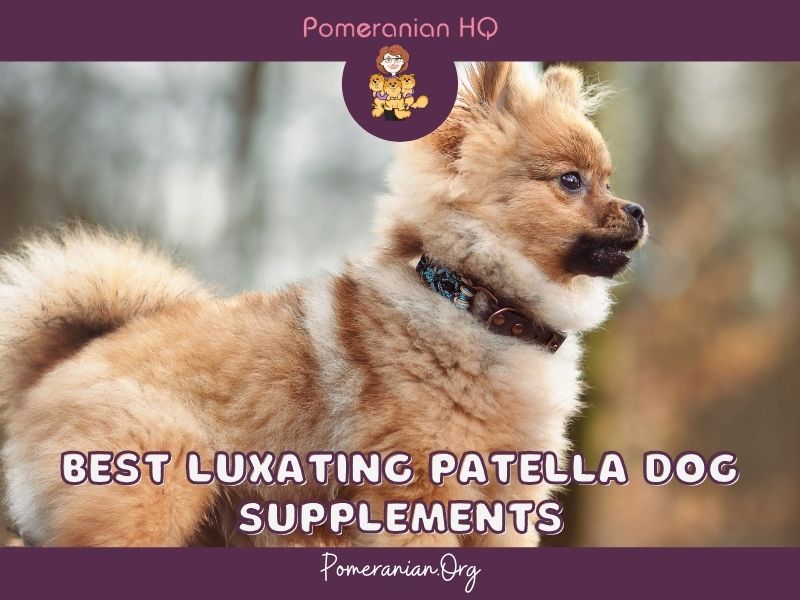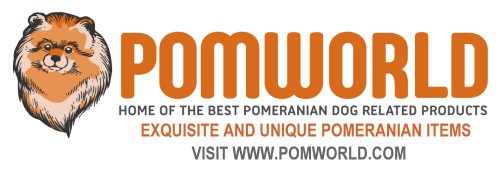Last Updated on 24/04/2024 by Dochlaggie. Post first published on March 23, 2022.
If your Pomeranian is suffering from luxating patella or recovering from luxating patellar surgery, you are undoubtedly looking for supplements that can aid in the healing process for your dog. But do luxating patella dog supplements matter? If yes, then what supplements should you look for?
Let me tell you everything about luxating patella dog supplements. Why you should give your Pomeranian joint supplements for luxating patella in dogs and learn which are the better products. What ingredients you should be looking for in joint supplements for your dog’s health.
What exactly is a Luxating Patella?
A luxating patella is a health condition in which the dog’s knee cap slides out of its usual position. It is a relatively frequent condition in dogs. Even though little or toy breeds, such as Chihuahuas, Yorkshire Terriers, and Poms, are more susceptible to luxated patellas than larger breeds, this orthopedic issue can occur in any dog breed.
How does it Occur?
According to my experience, this happens when the canine patella/kneecap, which typically rests on the groove of the femur, moves out of its original position and misaligns with the femur. It might affect either one or both of the rear legs.
In most small canine companions, this misalignment happens medially or toward the interior of the leg. A luxating patella in a pup can also develop laterally; however, this is less frequent and often only occurs in size breeds.
When luxation of the patella appears, your pup may feel periodic hind limb “skipping,” ataxia, or a limb locking at an unusual angle. They revert to normal as if nothing happened after the realignment.
It is possible for dogs to suffer from luxating patellas due to traumatic injury. Still, it is more common than abnormalities cause them in their joint or limb structure, such as an atypically shallow groove in the femur where the kneecap sits or an exception in the area where the patella/kneecap attaches to the tibia, which causes the patella to luxate. These limb and joint modifications result in a shift in the stresses acting on the knee, leading to the patella’s luxation.

The Signs and Symptoms of a Luxating Patella
These are the following signs that I usually find in my dogs affected with luxating patella.
- Cry with pain (when trying to move knee).
- Inability to bend their patella/knee.
- Limping.
- Leg swelling.
- Taking a skipping stance while running.
- Sitting in an unusual position.
- Refuse to engage in physical activity.
How to manage Luxating Patella In Dogs?
There are three practical ways to cope with this ailment.
1. Consult with a veterinarian
I usually consult with my local veterinarian. So, I recommend you also contact your local vet first if your dog exhibits any of the signs of a luxating patella, regardless of whether or not they are in pain.
Luxating patella may significantly negatively impact your pup’s quality of life if left untreated and undetected for an extended period of time. Your veterinarian will be able to advise you on what you can do to help your pooch retain its quality of life, as well as prescribe drugs to assist you in managing your dog’s illness.
Fact: Vets can also assist in recommending surgery if it is necessary.
2. Maintain Control Over Your Dog’s Diet
Obesity has been shown to aggravate luxating patella (as I observed in my pups). I think obesity will put additional pressure and tension on a dog’s joints, making it more difficult for them to move and hastening the onset of canine arthritis.
I know stopping obesity is a difficult task, but it is critical for dogs to not be obese in order to avoid luxating patella. Raw diets are an excellent method by which I use to keep my pup’s weight under control.
3. Luxating Patella Dog supplements
Supplementing my dog’s diet with luxating patella supplements, in addition to their usual food, is quite beneficial and promotes healthy joints. My pups love these hip and joint supplements too. Market-oriented luxating patella dog supplements usually improve the overall health and function of all my pups’ joints.
They provide vital nutrients that support joint health, ligaments, and cartilage.
It took me some time to research the best quality supplements available for my canines suffering from luxating patellas, but eventually, I came up with a list of best recommendations for you to consider.
But first, let’s look at the elements that make for effective supplements for dogs with luxating patellas.
In the Best Dog Supplement for Luxating Patella (LP), look for the following ingredients:
Here are the most effective components that have been tried and tested, as well as what they do to your dog.
- Tumeric: Tumeric is high in curcumin, which has anti-inflammatory, painkiller, and anti-arthritic qualities that are quite effective. Turmeric-based luxating patella dog supplements may effectively alleviate a wide range of symptoms associated with canine joint difficulties, including swelling, soreness, rigidity, and pain.
- Selenium: Selenium is essential for repairing and remodeling damaged tissue, leading to stronger calcified tissues and more comfortable joints.
- Vitamins B’s, C, and E: These vitamins are essential in collagen production. Vitamins C and E, on the other hand, have powerful antioxidant capabilities. As a result, supplements containing these vitamins may help improve the general integrity of joints, heal and preserve connective tissues while avoiding cellular damage and stimulating cartilage regeneration.
- Glucosamine and chondroitin: These are two important components of bone and cartilaginous substances. Both these ingredients can slow/reduce the deterioration of bone/cartilage and may effectively alleviate the stress that comes with the misaligned knee.
- Omega-3 fatty acids: These fats have powerful anti-inflammatory characteristics, and they may aid in the reduction of swelling, the alleviation of pain, the prevention of cartilage degeneration, and the improvement of general joint mobility.
- Methylsulfonylmethane (MSM): MSM plays an important function in collagen formation and may be used to minimize muscular spasms and pain signals in the body. Luxating patella supplements containing MSM may help lessen the symptoms of arthritis and aid in healing cartilaginous tissues.
- Coenzyme Q10 (CoQ10): It is a powerful antioxidant that can assist in reducing inflammation in your dog’s joints. CoQ10 is found in many foods and luxating patella dog supplements.
- Hyaluronic acid (HA): Serves as an absorber and lubricator for the joints. Usually, the best dog supplement for luxating patella is high in HA. It may assist in guaranteeing that your dog’s joints are working efficiently.
Best supplements for luxating patella in dogs
Here are the top 3 best dog supplements for luxating patella:
1. All-Natural Hip and Joint Supplement for Dogs
On my list of best supplements for luxating patella in dogs, All Natural hip & joint supplement is at the top.
This luxating patella canine supplement is completely natural and made with human grade ingredients to support joint health. So there will be no negative side issues. And it is for this reason that they are so loved by dog owners (as well as pets) and me.
All-Natural hip and joint supplement has assisted many of my dogs suffering from the luxating patella and helps in improving their general health. Within 10-14 days of taking this All-Natural supplement, my dogs usually get up from their couches and wish for long walks!
I also want to share that this supplement includes all the beneficial ingredients mentioned above, such as turmeric, glucosamine, and MSM.
I think any owner should give joint-affected pets these best dog supplements because after giving your pet these all-natural chewy treats, you will notice a significant increase in his or her activity level.
Pros
- Ingredients of human-grade quality, with no negative effects.
- Made in the United States with ethical consideration.
- Increased energy levels in the dog, enhanced overall health and decreased inflammation.
- All dog breeds can benefit from this powerful combination.
Cons
- Some tiny dogs found these treats to be difficult to chew on.
2. Nutramax Laboratories’ Cosequin Maximum Strength Joint Supplement
Next on my list, I think Cosequin Maxim is better fitted because it is one of the most effective luxating patella dog supplements available.
It is formulated with active substances that provide benefits in a short period of time. Magnesium, SCS, Glucosamine, and HA are just a few of the components in this product that positively influence a dog’s knee health and on dog arthritis.
In addition, Cosequin contains Methylsulfonylmethane, which is a powerful antioxidant that aids in the healing of damaged tissue and reduces inflammation (as discussed above)
Although the label claims that you will notice effects in a month or five weeks, my experience suggests that your dog’s luxating patella condition improves drastically in less than 12 days (this attribute makes this Nutramax supplement as one of the best dog supplement for luxating patella)
Furthermore, this supplement is available as chewable pills, which allows us (the owners) to adjust the dosage according to the size of our dog and his/her unique requirements.
Pros
- Prevents the occurrence of pain and discomfort in the knee.
- It provides support for all the joints.
- It is a more potent version of MSM that is not available in other types of joint supplements.
- Increases energy levels while also assisting with a range of motion.
Cons
Some parents had to exert some effort to encourage their dogs to consume it.
3. Tippy Toes Turmeric & Glucosamine Chewable Tablets
Tippy Toes Turmeric & Glucosamine Chewable Tablets is my final choice for luxating patella-affected dogs. It is because it works best before and after luxating patellar surgery. It is also made from natural ingredients and free from allergens. The company’s founder is pleased to provide a personal touch in terms of product assistance too.
This supplement contains all the essential ingredients for pain relief, inflammation reduction, collagen formation, increased mobility, and a greater dose of turmeric, which is known for its natural detoxifying properties.
It should be noted that the Turmeric Super Blend contains some extra ingredients such as cinnamon and black pepper, which can be naturally healthy to your dog unless your dog is allergic to them. Finally, this amazing best dog supplement for luxating patella also contains beef liver powder and maple bacon seasoning, contributing to its distinct flavor.
Pros
- Free from allergens
- Complete complement for the maintenance of tissue health, joint health, and knee pain.
- It contains manganese, which is important for the preservation of bone health and collagen in the bones.
Cons
- Not too tasty.

Final Thoughts: Luxating Patella Dog Supplements
A luxating patella is a condition in which the kneecap moves out of its normal place. Toy and small dog breeds are more prone to luxated patellas than bigger ones, although the problem can affect any dog breed, regardless of its size or breed type.
Regular vet visits, surgery, balanced diet, exercise, and specific supplements can aid in pain reduction and managing luxating patella completely.
All-Natural Hip and Joint supplement is considered one of the best dog supplement for luxating patella. Other than that, I hope you love my list of best dog supplements for a luxating patella.
Product Links
- https://www.amazon.com/All-Natural-Hip-Joint-Supplement-Dogs/
- https://www.amazon.com/Cosequin-DS-Maximum-Strength-Chewable/
- https://www.amazon.com/Turmeric-Glucosamine-Chewable-Tablets-Dogs/
Copyright Pomeranian.org. All Rights Reserved.
N.B. This article regarding Pomeranian health issues was written in consultation with our resident veterinarian.
Dr. Muqeet Mushtaq
DVM, University of Animal and Veterinary Sciences, 2019
MSc. (Hons.) (Animal Breeding & Genetics), University of Agriculture Faisalabad, 2021
Please note: while I do discuss health, care, and behavioral issues, you should never use this information as a replacement for advice from qualified veterinarians, diagnoses, or recommended treatment regimes. If you have any worries about the health of your Pomeranian, your first contact should be your regular vet or, if you don’t yet have one, a vet that works locally. Never ignore or avoid treatment and advice from your vet because of a piece of information you have read on any website.
References and Further Reading:
[1] Official Standard of the Pomeranian (AKC). American Kennel Club, 2011.
[2] English Kennel Club Pomeranian Breed Standard, 2017.
[3] Denise Leo, The Pomeranian Handbook.
[4] Milo G. Denlinger “The Complete Pomeranian.”
[5] Kimbering Pomeranians “1891-1991”.
[6] William Taplin’s “The Sportsman’s Cabinet.”
[7] E. Parker “The Popular Pomeranian.”
[8] Lilla Ives “Show Pomeranians.”








